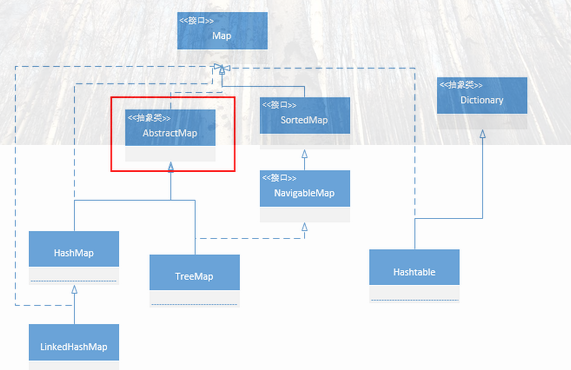HashMap(1.8)源码学习
一.HashMap介绍
1.哈希表(hash table)
在哈希表中进行添加,删除,查找等操作,时间复杂度为O(1)
存储位置 = f(关键字)
其中,这个函数f一般称为
哈希函数,这个函数的设计好坏会直接影响到哈希表的优劣将key通过哈希算法计算出
哈希值,把哈希值作为数组下标通过该方法建立的数组就叫做
哈希表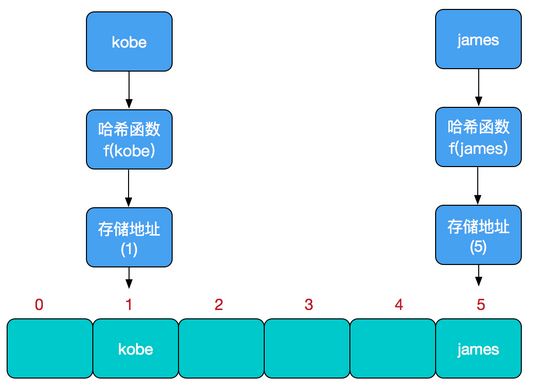
哈希冲突
当我们对某个元素进行哈希运算,得到一个存储地址,然后要进行插入的时候,发现已经被其他元素占用了,其实这就是所谓的哈希冲突,也叫哈希碰撞。
解决方案:
开放定址法
开放地执法有一个公式:Hi=(H(key)+di) MOD m i=1,2,…,k(k<=m-1)
其中,m为哈希表的表长。di 是产生冲突的时候的增量序列。如果di值可能为1,2,3,…m-1,称线性探测再散列。再散列函数法
当发生冲突时,使用第二个、第三个、哈希函数计算地址,直到无冲突时。缺点:计算时间增加。
链地址法(拉链法)
将所有关键字为同义词的记录存储在同一线性链表中
2.HashMap实现原理
2.1 Map
- HashMap是
Map的主要实现类,线程不安全的,效率高;可以存储null的key和value Map就是用于存储键值对(<key,value>)的集合类,也可以说是一组键值对的映射(数学概念),在java中map是一个接口,是和collection接口同一等级的集合根接口。- Map特点:
- key键值不可以重复
- 每个key只能对应一个value,多个key可以对应一个value
- key,value 都可以是任何引用类型(包括 null)的数据(只能是引用类型)
2.2 HashMap
HashMap是用
数组+单链表+红黑树实现的map类。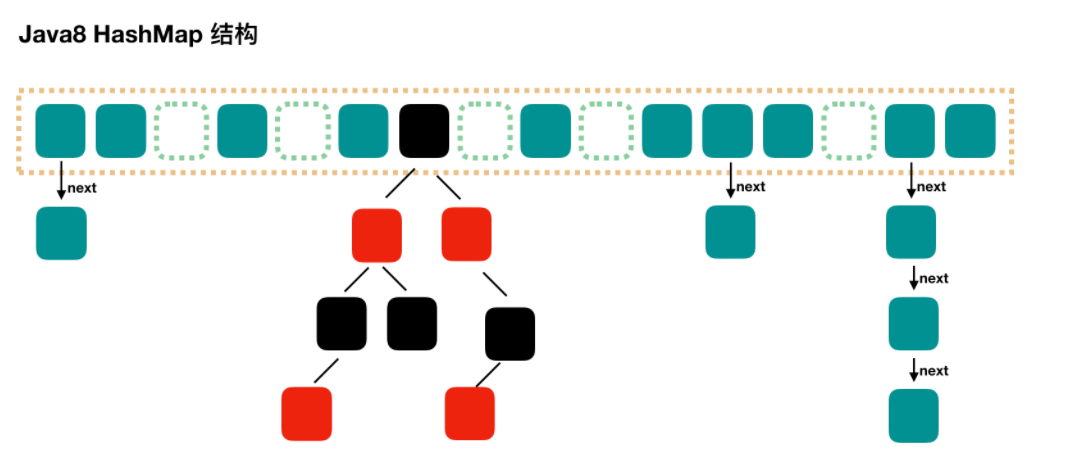
HashMap 的实现不是同步的,这意味着它不是线程安全的。
扩容机制和哈希函数越合理,空间成本越小,哈希函数计算结果越分散均匀。越分散发生哈希冲突的几率就越小
3.红黑树
、、、、、、、、
二.源码部分
1.基本属性
AbstractMap<K, V>:AbstractMap 提供了 Map 的基本实现,使得我们以后要实现一个 Map 不用从头开始,只需要继承 AbstractMap, 然后按需求实现/重写对应方法即可。
Map是Java集合框架的根接口,另一个是Collection接口
Cloneable接口是一个标记接口,也就是没有任何内容
Serializable接口之所以定义为空,是因为它只起到了一个标识的作用,告诉程序实现了它的对象是可以被序列化的,但真正序列化和反序列化的操作并不需要它来完成。
public class HashMap<K,V> extends AbstractMap<K,V>
implements Map<K,V>, Cloneable, Serializable {
private static final long serialVersionUID = 362498820763181265L;
/**
* The default initial capacity - MUST be a power of two.
* 默认的初始容量--必须是2的幂
*/
static final int DEFAULT_INITIAL_CAPACITY = 1 << 4; // aka 16
/**
* The maximum capacity, used if a higher value is implicitly specified
* by either of the constructors with arguments.
* MUST be a power of two <= 1<<30.
* 哈希表的最大容量为2^30
*/
static final int MAXIMUM_CAPACITY = 1 << 30;
/**
* The load factor used when none specified in constructor.
* 在构造函数中未指定时使用的负载系数,负载因子默认为0.75f
* 当元素的总个数>当前数组的长度 * 负载因子。数组会进行扩容,扩容为原来的两倍
*/
static final float DEFAULT_LOAD_FACTOR = 0.75f;
/**
* The bin count threshold for using a tree rather than list for a
* bin. Bins are converted to trees when adding an element to a
* bin with at least this many nodes. The value must be greater
* than 2 and should be at least 8 to mesh with assumptions in
* tree removal about conversion back to plain bins upon
* shrinkage.
* 当链表结点到达8时转换为红黑树
*/
static final int TREEIFY_THRESHOLD = 8;
/**
* The bin count threshold for untreeifying a (split) bin during a
* resize operation. Should be less than TREEIFY_THRESHOLD, and at
* most 6 to mesh with shrinkage detection under removal.
* 当红黑树结点小于6时重新转化为链表
*/
static final int UNTREEIFY_THRESHOLD = 6;
/**
* The smallest table capacity for which bins may be treeified.
* 可以树形化容器的最小表容量。
* (Otherwise the table is resized if too many nodes in a bin.)
* 否则,如果容器中的节点太多,则会调整表的大小
* Should be at least 4 * TREEIFY_THRESHOLD to avoid conflicts
* between resizing and treeification thresholds.
* 当Table所有元素超过该值,才会进行树化(为了防止前期阶段频繁扩容和树化过程冲突)
*/
static final int MIN_TREEIFY_CAPACITY = 64;
/* ---------------- Fields -------------- */
/**
* The table, initialized on first use, and resized as
* necessary. When allocated, length is always a power of two.
* (We also tolerate length zero in some operations to allow
* bootstrapping mechanics that are currently not needed.)
* node数组
*/
transient Node<K,V>[] table;
/**
* Holds cached entrySet(). Note that AbstractMap fields are used
* for keySet() and values().
* 存放键值对的集合
*/
transient Set<Map.Entry<K,V>> entrySet;
/**
* The number of key-value mappings contained in this map.
*键-值映射的数量
*/
transient int size;
/**
* The number of times this HashMap has been structurally modified
* 这个HashMap被结构修改的次数
* Structural modifications are those that change the number of mappings in
* the HashMap or otherwise modify its internal structure
* 结构修改是HashMap中那些改变映射数量的修改或修改其内部结构
* (e.g.,
* rehash). This field is used to make iterators on Collection-views of
* the HashMap fail-fast. (See ConcurrentModificationException).
*/
transient int modCount;
/**
* The next size value at which to resize (capacity * load factor).
*要调整大小的下一个大小值,边界值
* @serial
*/
// (The javadoc description is true upon serialization.
// Additionally, if the table array has not been allocated, this
// field holds the initial array capacity, or zero signifying
// DEFAULT_INITIAL_CAPACITY.)
int threshold;
/**
* The load factor for the hash table.
*哈希表的加载因子
* @serial
*/
final float loadFactor;
2.结构
- 如2.2中的图,顶层为动态数组,每个元素为一个node
而每个node又是一个链表的头节点
node的next指向下个hash值相同的结点
/**
* Basic hash bin node, used for most entries. (See below for
* TreeNode subclass, and in LinkedHashMap for its Entry subclass.)
* node内部类,node
*/
static class Node<K,V> implements Map.Entry<K,V> {
//当前的hash值
final int hash;
//键值
final K key;
//数据值
V value;
//指向node
Node<K,V> next;
//有参构造
Node(int hash, K key, V value, Node<K,V> next) {
this.hash = hash;
this.key = key;
this.value = value;
this.next = next;
}
//返回node键值的get方法
public final K getKey() { return key; }
//返回node数据的get方法
public final V getValue() { return value; }
public final String toString() { return key + "=" + value; }
public final int hashCode() {
return Objects.hashCode(key) ^ Objects.hashCode(value);
}
//value的set方法
public final V setValue(V newValue) {
V oldValue = value;
value = newValue;
return oldValue;
}
public final boolean equals(Object o) {
if (o == this)
return true;
if (o instanceof Map.Entry) {
Map.Entry<?,?> e = (Map.Entry<?,?>)o;
if (Objects.equals(key, e.getKey()) &&
Objects.equals(value, e.getValue()))
return true;
}
return false;
}
}
static final class TreeNode<K,V> extends LinkedHashMap.Entry<K,V> {
TreeNode<K,V> parent; // red-black tree links
TreeNode<K,V> left;
TreeNode<K,V> right;
TreeNode<K,V> prev; // needed to unlink next upon deletion
boolean red;
TreeNode(int hash, K key, V val, Node<K,V> next) {
super(hash, key, val, next);
}
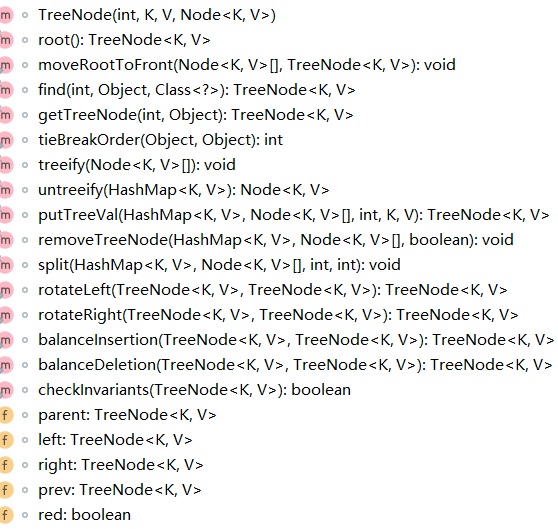
3.构造函数
/**
* Constructs an empty <tt>HashMap</tt> with the specified initial
* capacity and load factor.
*构造一个手动设置初始容量和负载因子的空hashmap
* @param initialCapacity the initial capacity
* @param loadFactor the load factor
* @throws IllegalArgumentException if the initial capacity is negative
* or the load factor is nonpositive
*/
public HashMap(int initialCapacity, float loadFactor) {
//如果设置的初始容量小于0,抛出异常
if (initialCapacity < 0)
throw new IllegalArgumentException("Illegal initial capacity: " +
initialCapacity);
//如果手动设置的初始容量大于最大容量,则设置为最大容量,即2^30 = 1,073,741,824
if (initialCapacity > MAXIMUM_CAPACITY)
initialCapacity = MAXIMUM_CAPACITY;
//如若设置的负载因子<=0 或者
//NaN全称是Not a Number,意思是“不是一个数字”,代表一种不合法,即float值和double值不合法。
if (loadFactor <= 0 || Float.isNaN(loadFactor))
throw new IllegalArgumentException("Illegal load factor: " +
loadFactor);
//将负载因子赋值
this.loadFactor = loadFactor;
//将初始容量的2次幂值赋给边界值
this.threshold = tableSizeFor(initialCapacity);
}
/**
* Constructs an empty <tt>HashMap</tt> with the specified initial
* capacity and the default load factor (0.75).
*使用指定的初始容量构造一个空的HashMap
* 负载因子为默认的0.75
* @param initialCapacity the initial capacity.
* @throws IllegalArgumentException if the initial capacity is negative.
*/
public HashMap(int initialCapacity) {
this(initialCapacity, DEFAULT_LOAD_FACTOR);
}
/**
* Constructs an empty <tt>HashMap</tt> with the default initial capacity
* (16) and the default load factor (0.75).
* 无参构造
* 初始容量为默认值 16
* 默认负载因子也为0.75
*/
public HashMap() {
this.loadFactor = DEFAULT_LOAD_FACTOR; // all other fields defaulted
}
/**
* Constructs a new <tt>HashMap</tt> with the same mappings as the
* specified <tt>Map</tt>. The <tt>HashMap</tt> is created with
* default load factor (0.75) and an initial capacity sufficient to
* hold the mappings in the specified <tt>Map</tt>.
*根据传入的map,使用相同的映射构造一个新的HashMap
* 负载因子为0.75
* @param m the map whose mappings are to be placed in this map
* @throws NullPointerException if the specified map is null
*/
public HashMap(Map<? extends K, ? extends V> m) {
this.loadFactor = DEFAULT_LOAD_FACTOR;
putMapEntries(m, false);
}
/**
* Returns a power of two size for the given target capacity.
* 返回给定目标容量的2次幂大小
* 由于HashMap的capacity都是2的幂,因此这个方法用于找到大于等于initialCapacity的最小的2的幂(initialCapacity如果就是2的幂,则返回的还是这个数)。
*/
static final int tableSizeFor(int cap) {
//cap-1是当进入的数本身为二次幂数而进行转换
//让最高位的1后面的位全变为1,最后加1,就得到了2次幂大小
//当32为都为1的时候,容量为MAXIMUM_CAPACITY
int n = cap - 1;
n |= n >>> 1;
n |= n >>> 2;
n |= n >>> 4;
n |= n >>> 8;
n |= n >>> 16;
return (n < 0) ? 1 : (n >= MAXIMUM_CAPACITY) ? MAXIMUM_CAPACITY : n + 1;
}
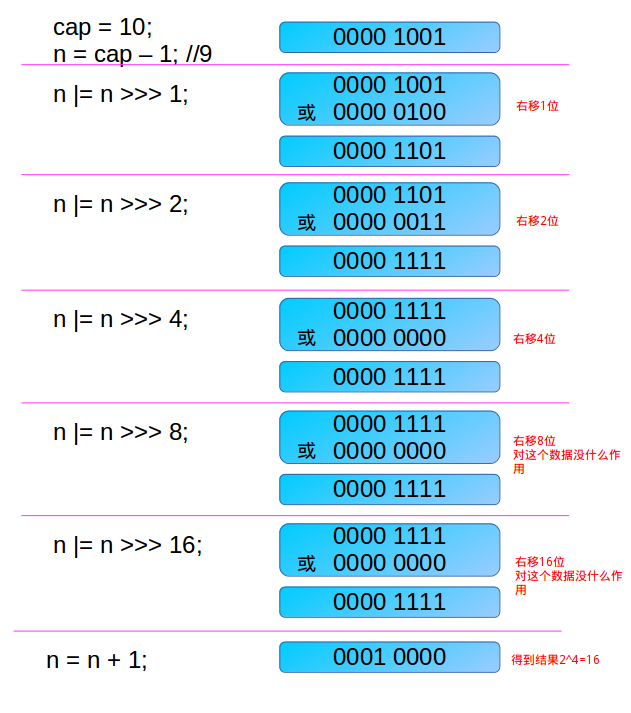
4.hashcode

Java中的hashCode方法就是根据一定的规则将与对象相关的信息(比如对象的存储地址,对象的字段等)映射成一个数值,这个数值称作为散列值。
由于和(length-1)运算,length 绝大多数情况小于2的16次方。所以始终是hashcode 的低16位(甚至更低)参与运算。要是高16位也参与运算,会让得到的下标更加散列。
static final int hash(Object key) {
int h;
//h >>> 16是用来取出h的高16,(>>>是无符号右移)
return (key == null) ? 0 : (h = key.hashCode()) ^ (h >>> 16);
}
5.get方法
public V get(Object key) {
Node<K,V> e;
//找不到键映射的值,返回null,否则返回value
return (e = getNode(hash(key), key)) == null ? null : e.value;
}
/**
* Implements Map.get and related methods
*get操作是通过调用getNode方法
* @param hash hash for key
* @param key the key
* @return the node, or null if none
*/
final Node<K,V> getNode(int hash, Object key) {
//
Node<K,V>[] tab; Node<K,V> first, e; int n; K k;
//在table不为空的情况下
if ((tab = table) != null && (n = tab.length) > 0 &&
(first = tab[(n - 1) & hash]) != null) {
//哈希碰撞几率小,为了效率考虑,总是检查第一个节点是不是我们想要的
if (first.hash == hash && // **always check first node**
((k = first.key) == key || (key != null && key.equals(k))))
return first;
//以下为first node不是目标结点的情况
if ((e = first.next) != null) {
//判断是否为红黑树对象
//instanceof是Java中的二元运算符,左边是对象,右边是类;当对象是右边类或子类所创建对象时,返回true;否则,返回false。
if (first instanceof TreeNode)
return ((TreeNode<K,V>)first).getTreeNode(hash, key);
//不是红黑树的话,链表向下查询即可
do {
if (e.hash == hash &&
((k = e.key) == key || (key != null && key.equals(k))))
return e;
} while ((e = e.next) != null);
}
}
//没找到,返回null
return null;
}
instanceof是Java中的二元运算符,左边是对象,右边是类;当对象是右边类或子类所创建对象时,返回true;否则,返回false。
6.put方法
/**
* Associates the specified value with the specified key in this map.
* If the map previously contained a mapping for the key, the old
* value is replaced.
* 将键/值对添加到 hashMap 中
* 如果先前的映射包含一个键的映射,则旧的value被替换。
* @param key key with which the specified value is to be associated
* @param value value to be associated with the specified key
* @return the previous value associated with <tt>key</tt>, or
* <tt>null</tt> if there was no mapping for <tt>key</tt>.
* (A <tt>null</tt> return can also indicate that the map
* previously associated <tt>null</tt> with <tt>key</tt>.)
*/
public V put(K key, V value) {
//false: onlyIfAbsent,表示改变现有值
//true: 不处于创建模式
return putVal(hash(key), key, value, false, true);
}
/**
* Implements Map.put and related methods
*实现了地图Map.put及相关方法
* @param hash hash for key
* @param key the key
* @param value the value to put
* @param onlyIfAbsent if true, don't change existing value
* 如果为true,则不更改现有值
* @param evict if false, the table is in creation mode.
* 如果为false,则表示表处于创建模式
* @return previous value, or null if none
*/
final V putVal(int hash, K key, V value, boolean onlyIfAbsent,
boolean evict) {
Node<K,V>[] tab; Node<K,V> p; int n, i;
//如果table为空,则进行扩容操作
if ((tab = table) == null || (n = tab.length) == 0)
//n 为扩容后的长度
n = (tab = resize()).length;
//如果 tab[i]为空,则新建结点
if ((p = tab[i = (n - 1) & hash]) == null)
tab[i] = newNode(hash, key, value, null);
else {
Node<K,V> e; K k;
//n = (tab = resize()).length
//p目前指向tab[i = (n - 1) & hash],也就是数组的最后一个元素
//如果p的hash有相同的,且key != null,说明键值已经存在了
if (p.hash == hash &&
((k = p.key) == key || (key != null && key.equals(k))))
//把p存储在e中
e = p;
//如果p结点为红黑树结点
else if (p instanceof TreeNode)
e = ((TreeNode<K,V>)p).putTreeVal(this, tab, hash, key, value);
else {
//遍历链表
for (int binCount = 0; ; ++binCount) {
//如果p结点没有后继结点,则新建链表节点
if ((e = p.next) == null) {
p.next = newNode(hash, key, value, null);
//插入结点后判断边界值,检查是否需要把链表转化为红黑树
if (binCount >= TREEIFY_THRESHOLD - 1) // -1 for 1st
treeifyBin(tab, hash);
break;
}
//判断链表中的结点是否有相同键值
if (e.hash == hash &&
((k = e.key) == key || (key != null && key.equals(k))))
break;
//p = p.next;
p = e;
}
}
//如果e不为空说明hashmap本来就存储了键值
if (e != null) { // existing mapping for key
//把原来的vlue保存起来
V oldValue = e.value;
//当相同可以修改的时候,进行重新赋值操作
if (!onlyIfAbsent || oldValue == null)
e.value = value;
//继承HashMap的LinkedHashMap类服务的
afterNodeAccess(e);
return oldValue;
}
}
++modCount;
//在进行一次扩容判断
if (++size > threshold)
resize();
//继承HashMap的LinkedHashMap类服务的
afterNodeInsertion(evict);
return null;
}

7.resize()方法
/**
* Initializes or doubles table size. If null, allocates in
* accord with initial capacity target held in field threshold.
* Otherwise, because we are using power-of-two expansion, the
* elements from each bin must either stay at same index, or move
* with a power of two offset in the new table.
* 初始化或加倍表大小
* @return the table
*/
final Node<K,V>[] resize() {
Node<K,V>[] oldTab = table;
//旧容量
int oldCap = (oldTab == null) ? 0 : oldTab.length;
//旧阈值
int oldThr = threshold;
int newCap, newThr = 0;
//如果旧的容量大于0,则以2的幂次加倍table的容量
if (oldCap > 0) {
//如果容量已经为最大值时,将边界值也赋值成最大值,返回原来的table
if (oldCap >= MAXIMUM_CAPACITY) {
threshold = Integer.MAX_VALUE;
return oldTab;
}
//newCap * 2 小于最大容量,且oldCap大于等于默认容量(已经初始化过的table),阈值 * 2
else if ((newCap = oldCap << 1) < MAXIMUM_CAPACITY &&
oldCap >= DEFAULT_INITIAL_CAPACITY)
newThr = oldThr << 1; // double threshold
}
//oldCap <= 0,但是oldThr > 0,说明构造hashtable对象时,手动设置了容量
else if (oldThr > 0) // initial capacity was placed in threshold 初始容量设置为threshold
newCap = oldThr;
else { // zero initial threshold signifies using defaults 零初始阈值表示使用默认值,16
newCap = DEFAULT_INITIAL_CAPACITY;
newThr = (int)(DEFAULT_LOAD_FACTOR * DEFAULT_INITIAL_CAPACITY);
}
//??
if (newThr == 0) {
float ft = (float)newCap * loadFactor;
newThr = (newCap < MAXIMUM_CAPACITY && ft < (float)MAXIMUM_CAPACITY ?
(int)ft : Integer.MAX_VALUE);
}
//边界值更改
threshold = newThr;
//告诉编译器忽略指定的警告,不用在编译完成后出现警告信息。
@SuppressWarnings({"rawtypes","unchecked"})
//扩容后,新建数组保存旧数组
Node<K,V>[] newTab = (Node<K,V>[])new Node[newCap];
table = newTab;
//如果原数组不为空,则需要将新的数组都逐个拷贝到新的数组中
if (oldTab != null) {
for (int j = 0; j < oldCap; ++j) {
Node<K,V> e;
//如果 j 结点不为空,则将其先保存在e中,并将原结点设置为null
if ((e = oldTab[j]) != null) {
oldTab[j] = null;
//如果该结点没有后继结点(树,链表),直接把这个结点放在新的数组中
//根据当前节点的hash值与新数组容量减1做&运算,得到新数组的插入位置
if (e.next == null)
newTab[e.hash & (newCap - 1)] = e;
//不只有一个结点,首先判断是否为树节点
else if (e instanceof TreeNode)
((TreeNode<K,V>)e).split(this, newTab, j, oldCap);
else { // preserve order 维护秩序
Node<K,V> loHead = null, loTail = null;
Node<K,V> hiHead = null, hiTail = null;
Node<K,V> next;
do {
next = e.next;
//新的位置在原位置
if ((e.hash & oldCap) == 0) {
//目前数组为空
if (loTail == null)
loHead = e;
else
//尾插法
loTail.next = e;
loTail = e;
}
else {
//新的位置在原长度+原位置的位置
if (hiTail == null)
hiHead = e;
else
hiTail.next = e;
hiTail = e;
}
} while ((e = next) != null);
if (loTail != null) {
//再将最后的结点赋值为null
loTail.next = null;
//再将数组头节点赋给数组
newTab[j] = loHead;
}
//高位同样操作
if (hiTail != null) {
hiTail.next = null;
newTab[j + oldCap] = hiHead;
}
}
}
}
}
//返回新的数组
return newTab;
}

8.遍历方法
先遍历key,再取出value
/**
* Returns a {@link Set} view of the keys contained in this map.
* The set is backed by the map, so changes to the map are
* reflected in the set, and vice-versa. If the map is modified
* while an iteration over the set is in progress (except through
* the iterator's own <tt>remove</tt> operation), the results of
* the iteration are undefined. The set supports element removal,
* which removes the corresponding mapping from the map, via the
* <tt>Iterator.remove</tt>, <tt>Set.remove</tt>,
* <tt>removeAll</tt>, <tt>retainAll</tt>, and <tt>clear</tt>
* operations. It does not support the <tt>add</tt> or <tt>addAll</tt>
* operations.
* 返回 hashMap 中所有 key 组成的集合视图
* @return a set view of the keys contained in this map
*/
public Set<K> keySet() {
Set<K> ks = keySet;
if (ks == null) {
ks = new KeySet();
keySet = ks;
}
return ks;
}
然后通过get方法都得到value
直接遍历value
/**
* Returns a {@link Collection} view of the values contained in this map.
* The collection is backed by the map, so changes to the map are
* reflected in the collection, and vice-versa. If the map is
* modified while an iteration over the collection is in progress
* (except through the iterator's own <tt>remove</tt> operation),
* the results of the iteration are undefined. The collection
* supports element removal, which removes the corresponding
* mapping from the map, via the <tt>Iterator.remove</tt>,
* <tt>Collection.remove</tt>, <tt>removeAll</tt>,
* <tt>retainAll</tt> and <tt>clear</tt> operations. It does not
* support the <tt>add</tt> or <tt>addAll</tt> operations.
* 返回 hashMap 中存在的所有 value 值。
* @return a view of the values contained in this map
*/
public Collection<V> values() {
Collection<V> vs = values;
if (vs == null) {
vs = new Values();
values = vs;
}
return vs;
}
通过遍历entry来取key和value
/**
* Returns a {@link Set} view of the mappings contained in this map.
* The set is backed by the map, so changes to the map are
* reflected in the set, and vice-versa. If the map is modified
* while an iteration over the set is in progress (except through
* the iterator's own <tt>remove</tt> operation, or through the
* <tt>setValue</tt> operation on a map entry returned by the
* iterator) the results of the iteration are undefined. The set
* supports element removal, which removes the corresponding
* mapping from the map, via the <tt>Iterator.remove</tt>,
* <tt>Set.remove</tt>, <tt>removeAll</tt>, <tt>retainAll</tt> and
* <tt>clear</tt> operations. It does not support the
* <tt>add</tt> or <tt>addAll</tt> operations.
* 返回键值对
* @return a set view of the mappings contained in this map
*/
public Set<Map.Entry<K,V>> entrySet() {
Set<Map.Entry<K,V>> es;
return (es = entrySet) == null ? (entrySet = new EntrySet()) : es;
}
通过foreach方法直接遍历key和value
//对 hashMap 中的每个映射执行指定的操作。
@Override
// BiConsumer是一个功能接口。 它接受两个参数,但不返回任何内容
public void forEach(BiConsumer<? super K, ? super V> action) {
Node<K,V>[] tab;
//如果action为0,则抛出异常
if (action == null)
throw new NullPointerException();
//如果size大于0, 并且将table 赋给tab
if (size > 0 && (tab = table) != null) {
int mc = modCount;
//遍历哈希表
for (int i = 0; i < tab.length; ++i) {
//遍历表上的链表节点或者树节点
for (Node<K,V> e = tab[i]; e != null; e = e.next)
action.accept(e.key, e.value);
}
if (modCount != mc)
throw new ConcurrentModificationException();
}
}
9.remove方法
/**
* Removes the mapping for the specified key from this map if present.
* 删除 hashMap 中指定键 key 的映射关系
* @param key key whose mapping is to be removed from the map
* @return the previous value associated with <tt>key</tt>, or
* <tt>null</tt> if there was no mapping for <tt>key</tt>.
* (A <tt>null</tt> return can also indicate that the map
* previously associated <tt>null</tt> with <tt>key</tt>.)
*/
public V remove(Object key) {
Node<K,V> e;
//调用removeNode方法,若无则返回null,否则返回value
return (e = removeNode(hash(key), key, null, false, true)) == null ?
null : e.value;
}
/**
* Implements Map.remove and related methods
* 实现了MAP移除及相关方法
* @param hash hash for key
* @param key the key
* @param value the value to match if matchValue, else ignored
* @param matchValue if true only remove if value is equal
* 如果为true,只在value相等时移除
* @param movable if false do not move other nodes while removing
* 如果为false,则在移除时不要移动其他节点
* @return the node, or null if none
*/
final Node<K,V> removeNode(int hash, Object key, Object value,
boolean matchValue, boolean movable) {
Node<K,V>[] tab; Node<K,V> p; int n, index;
//同样的在复制的同时,做一个合法性检查
if ((tab = table) != null && (n = tab.length) > 0 &&
(p = tab[index = (n - 1) & hash]) != null) {
Node<K,V> node = null, e; K k; V v;
//如果头节点就是目标结点,就将这个节点保存起来
if (p.hash == hash &&
((k = p.key) == key || (key != null && key.equals(k))))
node = p;
//如果不是,就遍历链表或者红黑树
else if ((e = p.next) != null) {
if (p instanceof TreeNode)
node = ((TreeNode<K,V>)p).getTreeNode(hash, key);
else {
do {
//判断key值相等,则为目标节点
if (e.hash == hash &&
((k = e.key) == key ||
(key != null && key.equals(k)))) {
node = e;
break;
}
p = e;
//直到结点遍历完
} while ((e = e.next) != null);
}
}
//在结点找到,且matchValue为false 或者 两个value相等的时候,则删除结点
if (node != null && (!matchValue || (v = node.value) == value ||
(value != null && value.equals(v)))) {
//当该结点为红黑树的时候
if (node instanceof TreeNode)
((TreeNode<K,V>)node).removeTreeNode(this, tab, movable);
//如果node为头节点,则将其next变成头节点
else if (node == p)
tab[index] = node.next;
else
//这时p为e的前驱结点,就将node删除
p.next = node.next;
++modCount;
--size;
afterNodeRemoval(node);
//返回结点
return node;
}
}
return null;
}
三.总结
HashMap的初始长度为什么是16?每次自动扩展或是手动初始化时,长度为什么是2的幂?
- HashMap的默认长度为16,15的二进制为1111,做与运算的时候,降低了hash碰撞的几率
- 容量为2的整数幂是为了让(2^n)-1的二进制是全1 的,符合hash均匀分布的原则
为什么要引入红黑树?
为了提高查询效率,故在JDK1.8中引入了改进方法红黑树。此数据结构的平均查询效率为O(log n) 。
什么是加载因子、负载因子、边界值?
加载因子:用于表示哈希表中元素填满的程度。
加载因子越大,填满的元素越多,好处是,空间利用率高了,但,冲突的机会加大了.反之,亦同。
冲突的机会越大,则查找的成本越高.反之,查找的成本越小.因而,查找时间就越小.
默认的加载因子: static final float DEFAULT_LOAD_FACTOR = 0.75f;
负载因子:等同于加载因子,也叫扩容因子
边界值: threshold
threshold=capacity*loadFactory
怎么计算key值的存储位置?
hash & (cap - 1)
扩容时:e.hash & oldCap
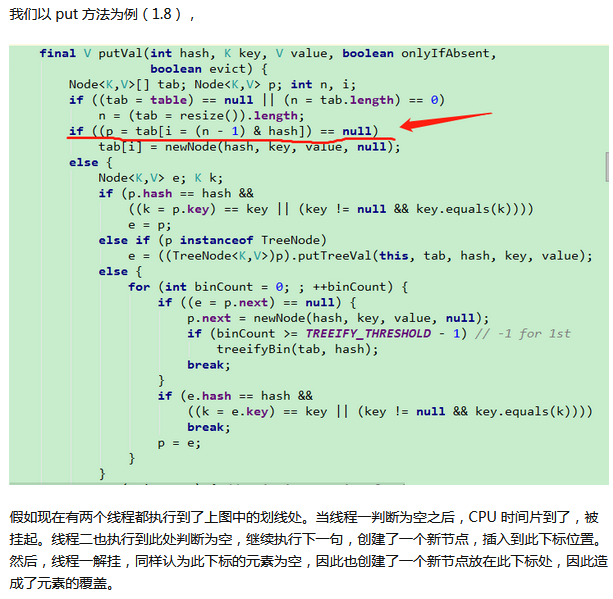
HashMap(1.8)源码学习的更多相关文章
- Java集合专题总结(1):HashMap 和 HashTable 源码学习和面试总结
2017年的秋招彻底结束了,感觉Java上面的最常见的集合相关的问题就是hash--系列和一些常用并发集合和队列,堆等结合算法一起考察,不完全统计,本人经历:先后百度.唯品会.58同城.新浪微博.趣分 ...
- HashMap与HashTable源码学习及效率比较分析
一.个人学习后的见解: 首先表明学习源码后的个人见解,后续一次依次进行分析: 1.线程安全:HashMap是非线程安全的,HashTable是线程安全的(HashTable中使用了synchroniz ...
- HashMap(1.7)源码学习
一. 1.7 和1.8区别 数据结构: 1.7: 数组 + 链表 1.8 : 数组 + 链表 + 红黑树 put: 1.7: 头插法 1.8: 尾插法 hash计算: 1.7 : Objects.ha ...
- hashMap源码学习记录
hashMap作为java开发面试最常考的一个题目之一,有必要花时间去阅读源码,了解底层实现原理. 首先,让我们看看hashMap这个类有哪些属性 // hashMap初始数组容量 static fi ...
- 基于jdk1.8的HashMap源码学习笔记
作为一种最为常用的容器,同时也是效率比较高的容器,HashMap当之无愧.所以自己这次jdk源码学习,就从HashMap开始吧,当然水平有限,有不正确的地方,欢迎指正,促进共同学习进步,就是喜欢程序员 ...
- HashSet源码学习,基于HashMap实现
HashSet源码学习 一).Set集合的主要使用类 1). HashSet 基于对HashMap的封装 2). LinkedHashSet 基于对LinkedHashSet的封装 3). TreeS ...
- HashMap的源码学习以及性能分析
HashMap的源码学习以及性能分析 一).Map接口的实现类 HashTable.HashMap.LinkedHashMap.TreeMap 二).HashMap和HashTable的区别 1).H ...
- 【JDK1.8】 Java小白的源码学习系列:HashMap
目录 Java小白的源码学习系列:HashMap 官方文档解读 基本数据结构 基本源码解读 基本成员变量 构造器 巧妙的tableSizeFor put方法 巧妙的hash方法 JDK1.8的putV ...
- JDK1.8源码学习-HashMap
JDK1.8源码学习-HashMap 目录 一.HashMap简介 HashMap 主要用来存放键值对,它是基于哈希表的Map接口实现的,是常用的Java集合之一. 我们都知道在JDK1.8 之前 的 ...
随机推荐
- 使用 arguments 对象
arguments 对象表示参数集合,它是一个伪类数组,拥有与数组相似的结构,可以通过数组下标的形式访问函数实参值,但是没有基础 Array 的原型方法. //函数没有定义形参,但是在函数体内通过 a ...
- Python的内存管理和垃圾回收机制
内存管理 Python解释器由c语言开发完成,py中所有的操作最终都由底层的c语言来实现并完成,所以想要了解底层内存管理需要结合python源码来进行解释. 1. 两个重要的结构体 include/o ...
- kafka时间轮的原理(一)
概述 早就想写关于kafka时间轮的随笔了,奈何时间不够,技术感觉理解不到位,现在把我之前学习到的进行整理一下,以便于以后并不会忘却.kafka时间轮是一个时间延时调度的工具,学习它可以掌握更加灵活先 ...
- leetcode 51. N皇后 及 52.N皇后 II
51. N皇后 问题描述 n 皇后问题研究的是如何将 n 个皇后放置在 n×n 的棋盘上,并且使皇后彼此之间不能相互攻击. 上图为 8 皇后问题的一种解法. 给定一个整数 n,返回所有不同的 n 皇后 ...
- DASCTF-Sept-X-浙江工业大学秋季挑战赛-pwn-wp
目录 DASCTF-Sept-X-浙江工业大学秋季挑战赛-pwn-wp 总结 datasystem check分析 漏洞点 利用思路 exp hehepwn 漏洞点 exp hahapwn 漏洞点 e ...
- 使用Cesium的地下渲染技术可视化瑞士的地质资源
Cesium中文网:http://cesiumcn.org/ | 国内快速访问:http://cesium.coinidea.com/ Camptocamp为瑞士拓扑的孪生数字增加了地下可视化功能. ...
- python17day
昨日回顾 自定义模块等 今日内容 自定义模块 模块是什么? 抖音:20万行代码全部放在一个py文件? 为什么不行? 代码多,读取时间长 代码不容易维护 所以应该? 一个py文件拆分100个文件,100 ...
- Mac iterm2 配色以及终端大小写敏感解决方案
iterm2是mac下非常好用的一款终端.但默认的配色实在不好用,经过一翻搜索终于找到了比较满意的,以下贴出博主的解决方案 配色 首先修改 ~/.bash_profile 加入一下代码 #enable ...
- Lesson3——NumPy 数据类型
NumPy 教程目录 NumPy 数据类型 numpy 支持的数据类型比 Python 内置的类型要多很多,基本上可以和 C 语言的数据类型对应上,其中部分类型对应为 Python 内置的类型. 下表 ...
- 使用Hot Chocolate和.NET 6构建GraphQL应用(7) —— 实现Query分页功能
系列导航 使用Hot Chocolate和.NET 6构建GraphQL应用文章索引 需求 GraphQL中的查询分页相对来说是查询中比较难理解的,接口的Schema也和其他不一样.在这篇文章中,我们 ...

